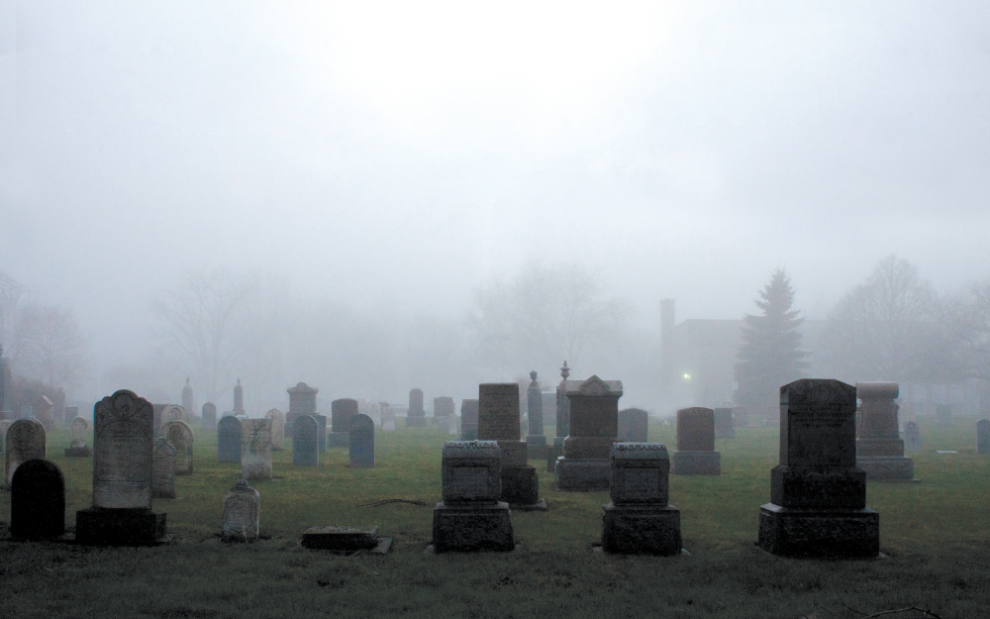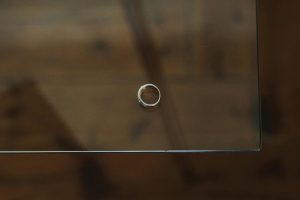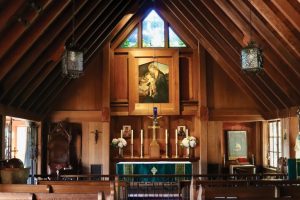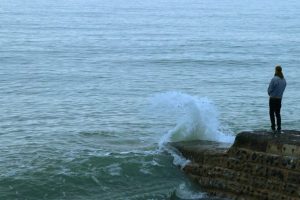In the 120-year-old May chapel at Rosehill Cemetery in Chicago, on a Sunday afternoon in November, I sit in a pew and jot down facts about death: Your hair and nails continue to grow after you die. Your remains can be made into a pencil or a diamond or be shot into space. I learn about the process from end of life to burial at this cemetery. I write down “alkaline hydrolysis,” a form of water cremation where your remains become sandy bone fragments. “I don’t want to be burned, the water sounds better,” someone in a pew in front of me says.
Funeral directors and cemetery workers stand at the front of the chapel, answering questions for the 10 or so people in the pews. The yellow stained glass in the chapel makes the room glow orange. There are Dunkin’ coffee and donuts at the entrance. Someone asks about cemetery ghost stories, and another wants to know rules around scattering ashes. “Lots of people want to be cremated and tossed in Lake Michigan,” one of the funeral directors says. “There are lots of people floating around in there.”
This event is a Death Cafe—a free, unscripted gathering for people to ask questions and talk about death. Jon Underwood started Death Cafes in the UK in 2011 as a social franchise where “people, often strangers, gather to eat cake, drink tea and discuss death.” Since then, Death Cafes have spread throughout 78 countries. Following the COVID-19 pandemic, there’s also been an increase in virtual Death Cafes.
Ashley Vehnekamp, who works for Dignity Memorial, coordinates the Death Cafes at Rosehill Cemetery. She was inspired to host them as a way to facilitate conversations about death and bring people into the cemetery who otherwise might not visit.
“People always ask about the grotesque and the morbid,” Vehnekamp says. “Then you get people who are forward thinking asking about human composting and green burial.”
Although Catholicism has a long tradition of memento mori (remembering and meditating upon one’s death as a spiritual practice), burying the dead as a corporal work of mercy, and teaching that bodies of the dead must be treated with respect, Catholics in the United States are still affected by the wider death-denying culture, which is uncomfortable with confronting mortality.
Burying the dead is expensive and entwined with corporate profit. Capitalism, ableism, white supremacy, and homophobia often rob people of their dignity and their bodies of respect in death. For many Catholics, death, even the death of loved ones, has become disembodied. However, Catholics can learn something from the many movements around the country that seek a new way of approaching death and dying.
Let’s talk about it
In 2011, the same year Death Cafes started, Caitlyn Doughty, a young funeral director dismayed at the exploitative state of the funeral industry, founded the Order of the Good Death, a funeral reform and death education advocacy group. The Order coined the term death positive, the idea that accepting death and talking about it should be normal. The term stands counter to modern culture’s anxiety around death and dying.
“There’s a disease, culturally, with acknowledging death or bringing it up as though it’s going to get you if you talk about it,” says Tiana Dargent, a death doula who started Queer Community Deathcare, an educational and advocacy organization centering around death and dying for the queer community. Dargent hosts virtual Death Cafes for LGBTQ and other queer people.
Death Cafes and spaces like them, she says, “allow for conversations to occur where people can explore and talk about death outside of a religious setting [or] their family cultural setting, and they can really come to their own ideas about what’s important to them around death and dying.”
After becoming interested in death care when her father died, Dargent wanted to volunteer at a queer hospice, but nothing like that existed at the time. This inspired her to start Queer Community Deathcare.
“[The queer community’s] considerations at end of life are different than those during the normative experience,” Dargent says. “There are lots of stories of a person dying who are memorialized using their former name. [If you have] chosen family, what are their rights? Or [if you’re] a trans person who wants a natural burial but has prosthetics, how do you navigate that? These are questions that are not taught, but they come up and clients have to advocate for themselves when they’re grieving or sick and dying.”
The Death Cafes Dargent hosts have become an online community of all ages, including many young people. Dargent also started a Discord channel for queer community members to share resources with one another related to end-of-life planning and death care. “Historically, goods and services [for end of life] are created with the ideal of the white, middle class, nuclear family in mind,” Dargent says. “Tons of people don’t fit in that, not just queer people.”
Facing grief
Talking about death is often intertwined with naming and acknowledging grief, which also carries stigma in the United States.
“Everything we face in life we face in death,” says Melissa Reyes, a queer death and birth companion with roots in Boriké (Puerto Rico) and Poland. Reyes hosts Death Cafes along with Batul True Heart, a two spirit Yoeme (Yaqui), Mexican, and Panamanian American traditional healer and death companion.
Reyes and True Heart started Floripondio End of Life Planning & Services, which is based in the San Francisco Bay Area and offers culturally conscious death care for queer, trans, Black, and Indigenous people; other people of color; and allies. They also offer an Embracing Endings class, which is a course that explores traditional nature-based ways of relating to the end of life.
Their Death Cafes are a place for this community to share their range of experiences relating to death, “knowing that even in death, homophobia shows up,” Reyes says. “Even in death, ableism shows up. Even in death, anti-Blackness shows up. We’re not escaping that.”
“Many of us, myself included, were raised to think and feel that death is taboo, that we don’t think or talk about it.”
Melissa ReyesAdvertisement
The work True Heart and Reyes do with Floripondio connects them to Indigenous ancestors who were healers and accompanied people in death, a major time of transition.
“In Indigenous societies around the world, there are more than two genders,” True Heart says. “We have words for them now, like two spirit, [though] they had, and many still have, their own language for these folks. Traditionally, we are like bridges to the spirit world. . . . This is very much who we are, who we were born to be.”
Talking about death and experiences of grief, Reyes says, can be nourishing when done in a community where one feels safe to explore those topics.
“Shaped by religion and capitalism and patriarchy, many of us, myself included, were raised to think and feel that death is taboo, that we don’t think or talk about it, that we grieve quietly by ourselves,” Reyes says. “Death positivity is undoing a lot of what I was raised to think about death.”
Creating opportunities for people to talk about death and grief alongside others motivated Candee Lucas, aftercare coordinator and chaplain at Catholic cemeteries for the Diocese of San Jose, California, to host Death Cafes and a grief support group at Santa Clara University, one of the only advertised Death Cafes hosted in a Catholic space.
“We had so many people [at the Death Cafes], so many ages, and since it was on campus, we often had people who saw the sign walking by who came in to talk,” Lucas says. “Sometimes people would wander in [after seeing our event] on the Death Cafe website. I realized a lot of people wanted to talk about death outside of when someone is dying, not when someone is in crisis but when someone has a calm head about them.”
At the Death Cafes, Lucas says, people tended to talk about “concerns and fears [around dying] more than the spirituality [of it], which came up more often in the grief support group.”
Lucas says there was a generational difference at the Death Cafes and grief support group among “older people who have been through some significant losses, like a parent or a spouse or sibling,” while younger people “had often experienced the death of someone due to suicide—a friend’s suicide, or a classmate everyone knew.” Death Cafes aren’t a grief support group, so Lucas says she would often refer people to a grief support group.
“All of us will either have received, have given, or will need [death] care eventually.” Brianna Lynn Hernández Baurichter
Acknowledging grief and finding creative ways to engage with it is what Brianna Lynn Hernández Baurichter, who is in her early 30s, does as an artist and death doula. She uses her art as an entry point for people to talk about death and dying. One of her series, Útiles Curativos, displays common caregiving tools as sacred and holy objects.
“I have this newer series, Aquí Descansamos (“Here We Rest”), that’s looking at green burial in a more whimsical way,” she says. “Instead of just a pine box, what if a casket was made out of moss and covered in mushrooms with banana leaves wrapped around the edges?”
At her art showings, people often approach her and open up about deaths they’ve experienced or their fears about it. “I’ve had people from older generations [see my art] and say, ‘I’ve never felt like I could talk about this, and this made me feel like it was okay,’ ” Hernández Baurichter says. “And same thing with younger generations.”
When Hernández Baurichter’s mother died in 2017, she “had a very traumatic experience because I had no idea what was going on,” she says. “A big part of what I try to do is to have more honest conversations about what grief looks like, to be that one person in the room who is like, ‘Have you thought about this?’ All of us will either have received, have given, or will need [death] care eventually. There’s no avoiding it, but there is a lot of delaying it. I feel very passionate about finding those entry points to avoid delaying it.”
As a death doula, Hernández Baurichter says her role is a nonmedical support person who fills in the gaps in death care, whether that’s supporting a person in their final days or helping young people start conversations about death with older family members. She says there’s a variety of ways to begin talking about death that don’t have to be serious or intimidating, and often humor or a movie or TV show can lend itself to having deeper discussions.
“I think people get very confused when we talk about death positivity, that we think everything is so wonderful and we love talking about death,” Hernández Baurichter says. “That’s kind of the surface idea of it, [but] it’s so important to meet people where they’re at.”
There are also deep layers of unspoken large-scale grief in our society, such as grief around climate change, police brutality, and the continued effects of the COVID-19 pandemic, True Heart says.
“Everything is much more public these days [with] social media,” they say. “We’re inundated a lot with death. We’re also going through a huge death of the planet right now. There’s climate grief, so much grief on so many levels. A lot of this grief and heaviness we’ve been feeling with the pandemic, a lot of marginalized communities have been feeling this way for generations. Now white people and wealthy people, everybody, are feeling this on some level.”
Talking about death and “really living life as if we’re going to die in the forefront is not only positive but it’s necessary,” True Heart says. “When we live like this, we don’t have time or energy to waste.”
Reclaiming death care
The “funeral industrial complex” in the United States is the most corporate and expensive in the world. The funeral industry, the Order of the Good Death argues, takes death care work and rituals from communities and puts them into an industry where bodies are whisked away as quickly as possible and buried or cremated for profit.
Navigating the funeral industry is confusing and often inaccessible, says Liz Dunnebacke, who started a Louisiana-based grassroots community care nonprofit called Wake, which provides resources for meaningful, affordable, and environmentally sustainable death care. Part of Wake’s work is hosting monthly Death Cafes in New Orleans.
“Nobody is looking into how the funeral industry operates. Then when they are faced with a death, they don’t have the time or the bandwidth to shop for services,” Dunnebacke says. “So we do a lot of helping families navigate.”
The funeral industry itself developed in the aftermath of the Civil War, after the invention of modern embalming. Since then, “there arose a professional class of funeral directors who started lobbying for some industry capture, and then all these laws started,” Dunnebacke says. “Such as, you can’t handle a body unless you have [a] credential. Suddenly it’s all professional.” In Louisiana, for example, the body is in the custody of a licensed funeral director from death until disposition.
“We get calls from clients who can’t come up with the money to be able to do anything with the body,” Dunnebacke says. “The big litmus for me is when I go on GoFundMe and look up memorial fundraising, and they boast that they raise more than [$330 million per year]. It’s the same concern [with] health-care expenses. You know the system is broken when people are trying to crowdfund for these basic human needs.”
Churches will sometimes financially help with funerals even if the person was not part of their community, and Wake often works with churches to help families. “That goes for Catholic churches and Baptist churches. There’s also a Muslim association that does burial for Muslim individuals, and Jewish family services here will do burial for free when there’s need,” Dunnebacke says. “[But] a lot of people don’t know how to connect with [churches], and a lot of times people don’t connect with those religions, and so it’s not always an obvious fit.”
“Death is hard. It’s messy. It’s painful no matter how much you prepare for it.” Melissa Reyes
In addition to the funeral industry disembodying people from death, it has also led to disconnection from rituals within families and traditions.
“This country is founded on the genocide of Indigenous people and the enslavement of African people,” True Heart says. “To this day, that legacy of control and death is in full force but is widely denied. Some cultures and elders within those cultures still have their grief practices and death rituals, while others have given them over to the funeral industry; it’s kind of been taken away.”
What Reyes sees happening is that “more and more people want to reclaim talking about death, want to reclaim death work, want to reclaim ritual and ceremony in their lives in general, and around death in particular.”
With Baby Boomers aging, Dunnebacke says, there’s been a “resurgence of a celebration of life, and doing [funerals] outdoors, with joy and laughter and celebration as opposed to a funerary approach.” Green burials and other sustainable death options are becoming more popular with Baby Boomers and generations after them, she says, and the laws will need to change with that.
Dunnebacke hopes that death care becomes “reintegrated in all aspects of society,” that restrictive laws ease up, and that the funeral industry “relinquishes its stronghold on this aspect of life, and that this work will return to communities and families.”
Honoring life
Many communities have long done death care on the margins, caring for those who are neglected by institutions and larger systems.
Peggy Hayes, a longtime member of DignityUSA, an organization that works for LGBTQ inclusion in the Catholic Church, was a young queer woman when she cared for those dying of AIDS in New York City from 1986 to 1993. “For those who were living through it, it was a mass death experience,” she says.
Hayes and others in the queer community learned to do death care in the cracks of a broken and abusive system. At the time, she says, there was only one funeral home in all of New York City that would accept the body of a person who died of AIDS.
“The hospital was a hostile place. There were situations in which a food tray for a patient was left outside the room,” she says. “Sometimes [my time visiting] was as simple as making sure that that person got their tray. For those who were people of faith, if they wanted to pray, [we’d] pray together. Or [I’d] simply bring the news from church or from our friendship group.”
Solidarity was a big part of why Hayes cared for people in the AIDS hospice. “This community I was part of was being so harshly treated by the world. There were vast amounts of social stigma,” she says, as the health-care system, the church, and so many other institutions abandoned people dying of AIDS.
“If the families of these people were not going to show up, then damn it, the rest of us were,” Hayes says. “We were not going to let them be alone. Communities rallied around an individual who was sick, provided all the love and support, and really honored the journey of that person into death. We had to take the place of all the systems that didn’t work.”
For Hayes, remembering the people she accompanied in the AIDS hospice and honoring their stories is a ritual.
“One person I visited for a long time was Michael, who ultimately died at the AIDS hospice,” Hayes says. “He was very creative and had real talent in clothes making. He worked in the garment industry in New York. I don’t think he had any visitors from the company where he had worked for a long time, so the fact that he pulled up that experience and told me about it, I was very honored.”
Hayes continues on to say, “I say Michael’s name out loud once a week. In our DignityUSA community in Boston, we do our regular prayers after the Liturgy of the Word. I have a list that I say out loud every week. It’s a prayer, to say their names out loud. Michael’s been gone since 1989 or 1990. I don’t think I’ve missed a week since. I don’t know where his ashes are, I don’t know if he has a headstone, I don’t know if anybody else is saying his name, but I’m saying his name.”
Those who do death care work know that “death is hard,” Reyes says. “It’s messy. It’s painful no matter how much you prepare for it. And there’s a really deep beauty in honoring the sacredness.”
After the Death Cafe at Rosehill, I walk around the cemetery, thinking about how burying the dead is a work of mercy. Facing, accepting, and talking about death is a mercy too—these acts strip away all that isn’t important, like illusions of control and possession and productivity. They reveal us to ourselves, they honor the lives of beloved dead. Talking about death is a first step to working toward a world where all can die a dignified death.
“[Death care] is this blend of facing the truth, of facing reality, of coming together so we can hold that reality and heal through it,” True Heart says. “This is what it’s all about. This is what life is all about.”
This article also appears in the November 2023 issue of U.S. Catholic (Vol. 88, No. 11, pages 26-30). Click here to subscribe to the magazine.
Image: Unsplash/Scott Rodgerson















Add comment